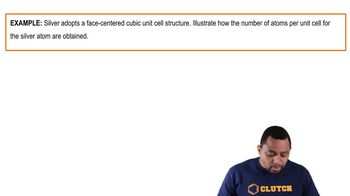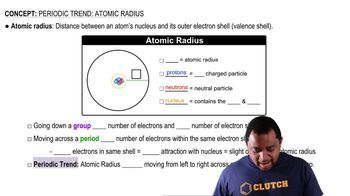Consider the unit cells shown here for three different structures that are commonly observed for metallic elements. (a) Which structure(s) corresponds to the densest packing of atoms?
Ch.12 - Solids and Modern Materials
Chapter 12, Problem 35
Iridium crystallizes in a face-centered cubic unit cell that has an edge length of 3.833 Å. (a) Calculate the atomic radius of an iridium atom. (b) Calculate the density of iridium metal.
 Verified step by step guidance
Verified step by step guidance1
Step 1: Understand the structure of a face-centered cubic (FCC) unit cell. In an FCC unit cell, atoms are located at each of the corners and the centers of all the faces of the cube. Each face-centered atom is shared between two adjacent unit cells.
Step 2: Relate the edge length of the FCC unit cell to the atomic radius. In an FCC structure, the face diagonal is equal to four times the atomic radius (4r). The face diagonal can also be expressed in terms of the edge length (a) as \( \sqrt{2}a \). Therefore, set up the equation \( 4r = \sqrt{2}a \) to solve for the atomic radius (r).
Step 3: Calculate the atomic radius of iridium using the edge length provided. Substitute the given edge length (3.833 Å) into the equation from Step 2 and solve for r.
Step 4: Determine the number of atoms per unit cell in an FCC structure. An FCC unit cell contains 4 atoms per unit cell (1/8 of an atom at each of the 8 corners and 1/2 of an atom at each of the 6 face centers).
Step 5: Calculate the density of iridium. Use the formula for density \( \text{Density} = \frac{\text{mass of atoms in unit cell}}{\text{volume of unit cell}} \). Find the mass of the atoms in the unit cell using the molar mass of iridium and Avogadro's number, and calculate the volume of the unit cell using the edge length.
Key Concepts
Here are the essential concepts you must grasp in order to answer the question correctly.
Face-Centered Cubic (FCC) Structure
In a face-centered cubic (FCC) structure, atoms are located at each corner of the cube and at the center of each face. This arrangement results in a high packing efficiency, with each unit cell containing four atoms. The relationship between the edge length and atomic radius in an FCC structure is given by the formula: atomic radius = edge length / (2√2). Understanding this geometry is essential for calculating the atomic radius of iridium.
Recommended video:
Guided course

Face Centered Cubic Example
Atomic Radius
The atomic radius is defined as the distance from the nucleus of an atom to the outermost shell of electrons. In the context of crystalline solids, it can be determined from the geometry of the crystal lattice. For FCC structures, the atomic radius can be derived from the unit cell dimensions, which is crucial for determining the size of the iridium atom in this problem.
Recommended video:
Guided course

Atomic Radius
Density Calculation
Density is defined as mass per unit volume and is a critical property of materials. For crystalline solids, density can be calculated using the formula: density = (mass of atoms in unit cell) / (volume of unit cell). In the case of iridium, knowing the atomic mass and the number of atoms per unit cell allows for the calculation of density, which is important for understanding the material's properties.
Recommended video:
Guided course

Density Concepts
Related Practice
Textbook Question
Textbook Question
Consider the unit cells shown here for three different structures that are commonly observed for metallic elements. (b) Which structure(s) corresponds to the least dense packing of atoms?
Textbook Question
Sodium metal (atomic weight 22.99 g/mol) adopts a body-centered cubic structure with a density of 0.97 g/cm3. (a) Use this information and Avogadro’s number (NA = 6.022 × 1023/mol) to estimate the atomic radius of sodium. (b) If sodium didn't react so vigorously, it could float on water. Use the answer from part (a) to estimate the density of Na if its structure were that of a cubic close-packed metal. Would it still float on water?
Textbook Question
Calcium crystallizes in a body-centered cubic structure at 467°C. (a) How many Ca atoms are contained in each unit cell?
